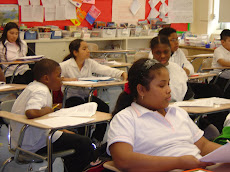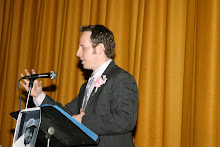Dear JHS 13 Community
Inquiry group work is a process that allows for teachers and staff to gather tools to work with students to help them progress academically and even socially and emotionally. The process identifies a key group of students based on test scores. For our school, we have been gathering a group who achieved high 2’s and low 3’s. From there, we use the data to identify any patterns and gather all the areas of deficiency. The next steps for us are to choose one area to address, identify one or two strategies to improve the area, and measure as to whether or not the strategies worked.
In the next week or so, we will be deciding on the area, selecting or creating one or two strategies, creating a pre and post assessment to use as a gage on the area, and then implementing the strategies. This work is very similar to what we did in our departments last year. For instance, math identified fractions to be a deficient area. We gave our students a pre and post assessment (the same one). We decided on two strategies. One worked with using our TPS to offer skill work on fractions (Fraction of the Day). We provided a fraction and the students had to add, subtract, divide, and multiply different fractions to the fraction of the day. The other was the Fraction Buster which was a question taken from the State Assessment with a fraction in it. This was supposed to be provided every day. We discovered that the Fraction of the Day did not have a profound impact compared to the people who did not use it at all and the Fraction Buster was difficult to implement. Regardless, if we had done the same exploration today, we would have discovered the drilling was not efficient use of time and the Fraction of the Day would not make it to our tool box of effective strategies. We would then use the next month to find a strategy that did work. We also would have explored ways to implement the Fraction Buster.
A big difference this year will be the cross curricular strategy rather than just within the departments. In math, we could decide on reformatting our workshop model to create time for different activities. In addition, fractions were connected to most topics through some type of problem even word problems. With different content areas, the curriculum may be the vehicle which will allow members of the academies to address an ELA or Math skill measured on their assessment. By inserting opportunities to incorporate what is believed to be efficient strategies to produce growth, alignment and consistency can flourish. Both are key to the improvement of our students academically and even behavior/socially. For example, if an academy identifies our students did not do well with extended response questions, then they can create an approach that all teachers will use for students to answer questions in all content areas by requiring the same three or four steps or using a graphic organizer to answer questions.
The inquiry process will be the catalyst for our conversations about instruction, learning, and what works with our students. As we continue to address cultural and day-to-day issues, what we discover through our inquiry process will begin to fill our tool box of effective strategies to use in the classroom. In the end, it will be these tools which will bring success in the classroom. Inevitably, it will improve our culture, bringing forth our mission of creating a learning environment that develops lifelong learners.
Sincerely,
Jacob T. Michelman
Principal
CHECKING IN WITH THE SCHOOL GOALS
GOALS 1 AND 2: 10% INCREASE OF STUDENTS MEETING PROFICIENCY IN ELA AND MATH
Each department has reviewed the data shared by the state on NYStart.gov. The data gave us an itemized listing of the skills our students were asked to show during the state exams. It provided a percentage and a comparison to the rest of the state. This is the same data we looked at in our Academies. The information is extremely helpful when planning out the curriculum because it allowed the teachers to compare what standards we are required to cover and what skills our students are struggling with. This brought forth our key standards and skills that need to be stressed throughout the school year for students to acquire mastery. In addition, if a certain skill is a large portion of the test and our students showed little to no progression, then the curriculum needs to stress this particular skill. This is the work the ELA and Math departments are doing.
Cabinet has been further exploring Robert Marzano’s. We have been devoting our time to developing a plan where students will be given a goal of critical thinking and/or writing. The model uses a rubric to rate the current state of the student and set up a plan to progress in one or both of the areas. Using the inquiry work and collaboration within Academies, we could support our students to reach their targets according to the rubric. The Cabinet will align the student goal plan with inquiry work, curriculum writing, and unit planning.
92% ATTENDANCE
The attendance team has put together an action plan of creating subcommittees to concentrate on incentives, developing a culture which stresses the importance of attendance, and accountability where we are not repeating attendance procedures several times throughout each day and each week and where everyone is contributing to attendance. We are boosting our incentives but also monitoring the effectiveness of our selections. We are putting plans together to close the gap on students who are late and students who are marked absent but are in the building. Each meeting we discuss any students with attendance below 90%. We are working with City Year and Attendance Court to provide individual and family support for the students struggling to turn their attendance around. Our current daily average is 90.8%. We know there is tremendous work to get the 1.2% to meet our goal. We also know we will need everyone’s participation to make it happen.
EXPANDING INTERVENTIONS TO PROVIDE ADDITIONAL SUPPORT FOR 15% OF OUR POPULATIONT
eacherease has been a great tool in allowing us to summarize student records and school statistics. The individual reports have proven on several occasions to be a useful tool with meeting with parents. In addition, we are able to identify any particular offenses to find out specific statistics such as locations, totals, and specific times of the day. There is so much potential in Teacherease we have not tapped into. As for Child Study team, there are concerns about the limited number of Child Study Referrals that have taken place to this date. The only ones completed are from members of the Child Study. With the large number of removals of specific children, the Child Study Team is hoping to get more buy-in from staff to make referrals on students who they are struggling with. Parents can also make recommendations to their counselors for support with their children.
CITY-WIDE SURVEY ACHIEVING “ABOVE AVERAGE OR HIGHER” ON ALL 12 CATEGORIES
The School Improvement Team has been working on the Strategic Plan for addressing the concerns of the school. Our areas of focus identified are academics, communication, environment and resources. We will be editing the mission statement to maintain the core values but shorten to increase its impact on focus on vision. Our staff development day morning was outlined by the School Improvement Team. The feedback from staff was positive and verified a good first step in addressing the concerns of the school.
On another note, City Year will be launching the Feather Incentive program sometime this month to direct more attention of the community on students who are doing great work and contributing to the core values of the school. Our data from last year showed significant growth in culture last year in the grade teams who used the system on a regular basis. Students who were recognized on a regular basis make more an effort of making better decisions on a regular basis when they are recognized for doing it. I encourage all academies in using the system to promote positive behavior and to focus more attention to the students doing the right thing.
Please continue to work hard toward our Destination of Excellence!
One School, One Future!
Subscribe to:
Post Comments (Atom)





No comments:
Post a Comment